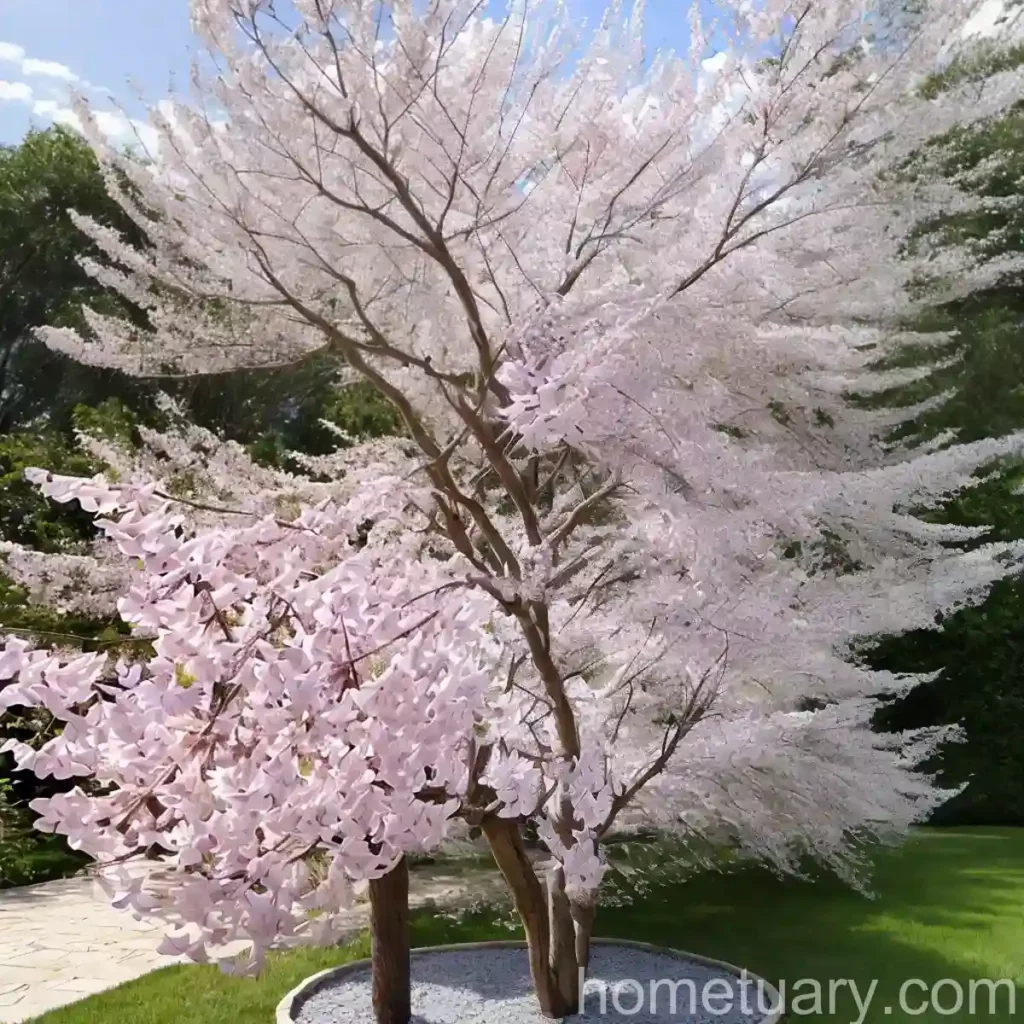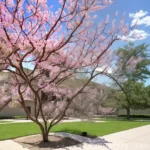All About Eastern Redbud (Cercis canadensis f. alba ‘Royal White’)
Introduction
Plants are an integral part of our ecosystem, providing us with oxygen, food, medicine, and aesthetic beauty. As a plant scientist, I am fascinated by the diversity and resilience of plant life. Among the vast array of plant species, the eastern redbud (Cercis canadensis f. alba ‘Royal White’) stands out as a captivating ornamental tree with its stunning white blossoms. In this comprehensive guide, we will explore the Eastern Redbud in detail, covering its culture, uses, maintenance requirements, common diseases, and propagation methods.
What is Cercis canadensis f. alba ‘Royal White’?
The Cercis canadensis f. alba ‘Royal White’, commonly known as the Eastern Redbud, is a deciduous tree native to eastern North America. It is a cultivar prized for its profusion of white flowers that adorn the branches in early spring, providing a spectacular display of natural beauty. The ‘Royal White’ variety is particularly renowned for its striking white blossoms against the backdrop of its heart-shaped leaves.
The features of the Eastern Redbud make it a popular choice for landscaping, adding an enchanting touch to gardens, parks, and urban landscapes. Its adaptability to various growing conditions and its ornamental value have made it a beloved tree among gardeners and horticulturists.
Key Takeaways – Eastern Redbud (Cercis canadensis f. alba ‘Royal White’)
Before we delve into the specifics of the Eastern Redbud, let’s first summarize the key takeaways of this beautiful tree:
- Scientific Name: Cercis canadensis f. alba ‘Royal White’
- Common Name: Eastern Redbud
- Other Names: White flowering redbud, Royal White redbud, Cercis canadensis alba, Cercis canadensis Royal White, White-flowering Eastern redbud, Eastern redbud alba, Cercis canadensis white flowers
- Type: Deciduous tree
- Distinctive Feature: Abundant white blossoms in early spring
- Foliage: Heart-shaped leaves
- Growth Habit: Small to medium-sized tree
- Uses: Ornamental, landscaping
- Hardiness Zone: 4-9
- Cultural Significance: Symbolizes love, peace, and rejuvenation
- Special Feature: Attracts pollinators, including bees and butterflies
With these key takeaways in mind, let’s explore the Eastern Redbud in greater detail, covering its culture, uses, and maintenance requirements.
Culture
Water
The Eastern Redbud is generally a low-maintenance tree, but it thrives when provided with regular watering, especially during its establishment phase. After planting, it is crucial to ensure that the tree’s root system remains consistently moist, but not waterlogged, to encourage healthy growth. Once established, the Eastern Redbud is moderately drought-tolerant, but it will benefit from supplemental watering during prolonged dry spells.
Sunlight
As a deciduous tree, the Eastern Redbud prefers full to partial sunlight. It thrives in locations with well-drained soil and ample sunlight, which promotes the tree’s flowering and overall vigor. While it can tolerate partial shade, providing it with at least 6 hours of sunlight per day will ensure optimal growth and blooming.
Fertilizer
Although the Eastern Redbud is relatively low-maintenance, it can benefit from a balanced fertilizer application in early spring, just before the tree enters its active growth phase. A slow-release, granular fertilizer formulated for flowering trees can provide the necessary nutrients for healthy foliage and abundant blooms. It is essential to follow the manufacturer’s recommendations regarding dosage and application methods to avoid over-fertilization, which can be detrimental to the tree’s health.
Soil
This versatile tree can adapt to various soil types, including loamy, sandy, or clay soils, as long as they are well-drained. It thrives in slightly acidic to neutral soil pH levels (pH 6.0-7.0). Before planting, it is beneficial to amend the soil with organic matter, such as compost or well-rotted manure, to improve its texture and fertility. Well-drained soil is critical to prevent waterlogging, as it can lead to root rot and other soil-borne diseases.
Uses
The Eastern Redbud is primarily prized for its ornamental value, making it a popular choice for landscaping, gardens, and urban green spaces. Here are some of its key uses:
- Ornamental Tree: Its stunning white blossoms make it a standout feature in any landscape, particularly when planted as a focal point or in small groups.
- Wildlife Habitat: The Eastern Redbud’s flowers and foliage attract pollinators such as bees and butterflies, contributing to the biodiversity of the surrounding ecosystem.
- Symbolism: In various cultures, the Eastern Redbud symbolizes love, peace, and the renewal of life, making it a meaningful addition to gardens with symbolic or thematic designs.
Pruning
The Eastern Redbud generally requires minimal pruning, especially when grown in its natural form. However, light pruning may be necessary to remove dead or damaged branches, shape the tree for aesthetic purposes, or promote better air circulation within the canopy. Pruning is best performed during the tree’s dormancy in late winter or early spring to minimize stress and encourage rapid wound healing.
Propagation
The Eastern Redbud can be propagated through several methods, including seeds, stem cuttings, and grafting. Here are the basic principles for each propagation method:
Seed Propagation
- Seed Collection: Collect mature seeds from the Eastern Redbud tree after the pods have fully developed and begin to dry out. The seeds are typically ready for collection in late summer to early fall.
- Seed Treatment: Some gardeners may scarify the seeds (lightly abrade the seed coat) or soak them in water overnight to promote germination.
- Sowing Seeds: Plant the seeds in containers or directly in the ground in the fall, providing them with some protection to overwinter. Alternatively, stratify the seeds in a refrigerator for 60-90 days before sowing them in the spring.
Stem Cuttings
- Cutting Selection: Take 4-6 inch semi-hardwood stem cuttings from the tree in late spring or early summer. Choose healthy, disease-free branches for propagation.
- Preparation: Remove the lower leaves from the cuttings, dip the cut ends in rooting hormone, and plant them in a well-draining, sterile rooting medium.
- Rooting: Keep the cuttings in a humid environment with indirect sunlight, ensuring that the rooting medium remains consistently moist. After several weeks, they should develop roots and can be transplanted into individual containers.
Grafting
- Scion Selection: Choose a healthy, disease-free branch from the Eastern Redbud tree to serve as the scion for grafting.
- Rootstock Preparation: Select a compatible rootstock (often a related Cercis species) and prepare it for grafting, ensuring a secure union between the scion and the rootstock.
- Grafting Procedure: Perform the grafting procedure – commonly cleft grafting or whip-and-tongue grafting – during the tree’s dormant season, typically in late winter.
- Aftercare: Carefully monitor the grafted tree, providing it with proper care and protection until the graft union is fully established.
Propagation of the Eastern Redbud can be an enriching horticultural experience, allowing plant enthusiasts to create new trees and preserve desirable cultivars for future generations.
Container Popularity
The Eastern Redbud is also suitable for container cultivation, making it a versatile option for small gardens, patios, and urban environments. When grown in containers, it can be effectively used to add vertical interest and ornamental value to outdoor spaces that have limited ground area.
Container Culture
If you plan to grow the Eastern Redbud in a container, consider the following cultural practices:
- Container Size: Choose a large, sturdy container with adequate drainage holes to accommodate the tree’s root system and provide stability.
- Soil Mix: Use a well-draining potting mix formulated for woody plants, ensuring that it offers good aeration and water-retention properties. Adding perlite or coarse sand can enhance drainage.
- Watering: Container-grown trees may require more frequent watering than those planted in the ground, as the soil in containers tends to dry out more rapidly. Ensure that the soil remains consistently moist, but not waterlogged, especially during hot and dry periods.
Common Diseases
While the Eastern Redbud is relatively resistant to pests and diseases, it is important to be vigilant and proactive in addressing any potential issues. Some of the common diseases that can affect the Eastern Redbud include:
- Cercospora Leaf Spot: Fungal disease manifesting as circular spots on the foliage, leading to leaf desiccation and defoliation.
- Anthracnose: Fungal infection causing irregularly shaped lesions on the leaves, which can lead to premature leaf drop.
- Verticillium Wilt: Soil-borne fungal disease that can cause wilting, yellowing, and dieback of branches.
Disease Diagnosis
Proper diagnosis of plant diseases is crucial for implementing effective management strategies. When dealing with potential disease issues in the Eastern Redbud, it is recommended to:
- Carefully Inspect the Tree: Look for visual symptoms such as leaf spots, lesions, wilting, or abnormal growth patterns.
- Consult Experts: Seek the advice of local horticultural extension services, botanical gardens, or certified arborists for accurate diagnosis and tailored recommendations.
- Implement Preventive Care: Maintain good cultural practices, including proper watering, pruning, and sanitation, to minimize the risk of disease development.
Common Pests
The Eastern Redbud is relatively resistant to major pest infestations, but it can occasionally encounter the following pests:
- Aphids: Small, soft-bodied insects that can cluster on the new growth, causing curling and distortion of leaves.
- Scale Insects: Infestations can lead to yellowing of leaves and overall decline in tree vigor.
- Japanese Beetles: These voracious feeders can skeletonize the foliage if present in large numbers.
Botanist’s Tips
As a plant scientist, I offer the following tips for cultivating and caring for the Eastern Redbud:
- Selecting a Site: Choose a location that provides well-drained soil, ample sunlight, and sufficient space for the tree to grow and flourish.
- Mulching: Apply a layer of organic mulch around the base of the tree to conserve soil moisture, regulate soil temperature, and suppress weed growth.
- Seasonal Care: Monitor the tree throughout the seasons, adjusting watering, fertilization, and maintenance practices based on its changing needs.
- Observation and Learning: Regularly observe the tree’s growth, flowering patterns, and interactions with the surrounding ecosystem to deepen your understanding of its biology and ecology.
Fun Facts
To further appreciate the uniqueness of the Eastern Redbud, here are some fun facts about this captivating tree:
- The Eastern Redbud’s flowers are not only visually striking but also edible. They can be used to add color and a delicate floral flavor to salads, desserts, and beverages.
- The heart-shaped leaves of the Eastern Redbud symbolize love, making it a meaningful tree for romantic or sentimental garden designs.
- Native American tribes, including the Cherokee, utilized various parts of the Eastern Redbud for traditional medicinal and cultural purposes.
Links to External Resources
For further exploration and in-depth information on the Eastern Redbud, I recommend the following external resources:
- Missouri Botanical Garden – Cercis canadensis f. alba ‘Royal White’
- University of Florida IFAS Extension – Eastern Redbud
- Virginia Tech Dendrology – Cercis canadensis
- North Carolina State University Extension – Redbud Diseases
- USDA Forest Service – Eastern Redbud
In conclusion, the Eastern Redbud (Cercis canadensis f. alba ‘Royal White’) is a remarkable tree with ornamental, ecological, and cultural significance. Its resilience, adaptability, and aesthetic appeal make it a cherished addition to diverse landscapes, from natural woodlands to cultivated gardens. Whether admired for its profusion of white blossoms in spring, its heart-shaped leaves, or its symbolic meanings, the Eastern Redbud remains a botanical gem worth cultivating and celebrating.
I hope this comprehensive guide provides you with valuable insights into the world of the Eastern Redbud and inspires you to appreciate and cultivate this iconic tree in your own botanical endeavors.
Research:
1. Botanical Society of America
2. International Society for Horticultural Science















